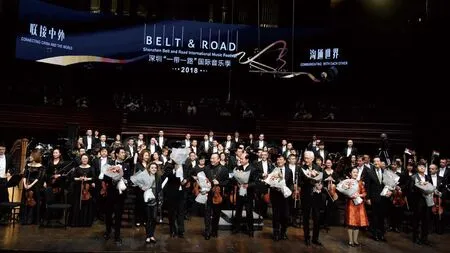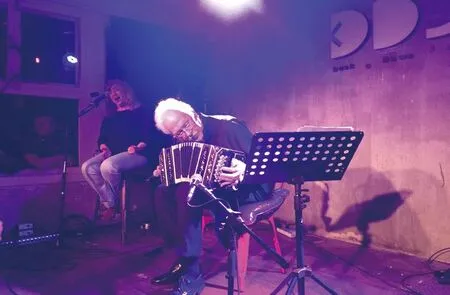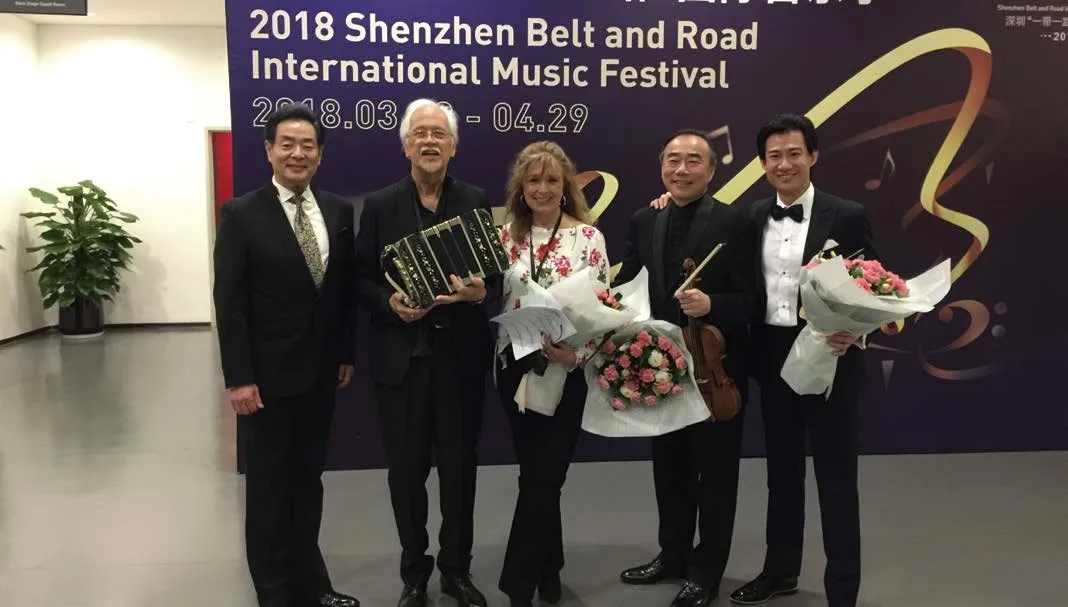音乐是如此美好!
——访阿根廷国宝级班多钮手风琴演奏家瓦特尔·里奥斯
2018-04-12张玉雯
文张玉雯

瓦特尔·里奥斯出席2018深圳“一带一路”国际音乐季开幕式演出,携手深圳交响乐团演奏了探戈大师皮亚佐拉的代表作《自由探戈》和《再见诺尼诺》Walter Rios attends the opening performance of 2018 Shenzhen "Belt and Road" international music season,and joins hands with the Shenzhen Symphony Orchestra to play the masterpiece of the tango master Piazzolla,Free Tango and Goodbye Nonino
瓦特尔·里奥斯是当今阿根廷国宝级班多钮手风琴演奏家、阿根廷探戈音乐的代表性人物。他被誉为阿斯托尔·皮亚佐拉的最佳传承者,他改编和演奏的阿斯托尔·皮亚佐拉代表作品被世人誉为后皮亚佐拉时代最不可超越的版本。所以,当这位艺术家千里迢迢来到中国的时候,我怎能错过对探戈音乐一探究竟的机会?
问:我听过很多版本的《自由探戈》,有各种器乐编配形式的,也有阿卡贝拉的,我很好奇是什么原因让这首作品如此风靡?
瓦特尔·里奥斯(以下简称“瓦”):《自由探戈》这首作品是为一个舞团创作,它是一个系列作品当中的一首,还有《美式探戈》等其他作品。这首作品基本上由一种节奏型贯穿始终,因为它的节奏固定,旋律轻快,可用来舞蹈。很有意思的是,曾经有一位旅居法国的非裔音乐家格雷斯·琼斯为《自由探戈》作了词然后唱了出来,当时皮亚佐拉很愤怒,认为这样的改编破坏了他的音乐,但是后来由于这一版本的流行让他收到了很多版税,他才发现原来这样还不错,能赚不少钱(笑)。阿根廷国家探戈研究院的创始人奥拉西奥·费雷尔也给皮亚佐拉的这首乐曲进行填词,主旋律部分有歌词,而到了变奏部分就变成了拟声词。每个人的编曲不一样,但核心是一样的。
问:您觉得应如何评判创作水平的高低?
瓦:皮亚佐拉的创作非常高产,比如《四季》《遗忘》都是属于他不同创作时期的作品,《四季》中的《冬》就是他自己其中最喜欢的一个乐章。作为作曲家,他自己会去评判自己的作品,哪首更好。我在洛杉矶的时候,曾经与“永远的探戈”舞团编配过一种《自由探戈》的版本;1997年在日本,也改编了一首《提琴探戈》,还有阿根廷舞者伴奏,也是大受欢迎。所以,听众也会去选择自己喜欢的作品。
问:很多国人开始关注到皮亚佐拉的探戈,大多源于马友友的那张专辑《探戈灵魂》,后来便逐渐在专业音乐学院的师生们的曲目单上流行开来。为什么是皮亚佐拉而不是其他的探戈作曲家得到如此广泛的国际认知?
瓦:这个主要有两个原因:首先是整个环境的因素,20世纪50至60年代,皮亚佐拉在阿根廷的境遇很不尽如人意,他开创的“新派探戈”在阿根廷国内遭受到极大的打击,特别是一些传统的探戈人的非议,这就导致他很难在阿根廷继续呆下去,最后只能走出国门;再加上他有非常强大的创作能力,所以自然而然就得到了其他国家音乐界的认可和接受。与之相对的是,其他的探戈音乐家在阿根廷呆得很惬意,也没有走出阿根廷的迫切动力,所以很少有像皮亚佐拉那样在国外呆了很长时间的人。第二个原因,皮亚佐拉的创作与西方的爵士、古典音乐有大量结合,更容易被西方听众所接受。
问:新事物的出现总是伴随着传统派的强烈反对,这是一个非常普遍的现象。
瓦:在阿根廷探戈历史当中,有两位非常重要的探戈人物。一位是卡洛斯·加德尔,我们所熟知的《一步之遥》就是他创作的。除此之外,他还创作了大量的作品,出演了多部电影。在加德尔出现之前,探戈整体风格是轻松愉悦的,但是加德尔把探戈变成了伤感的音乐。这在当时也遭到了很多人的抨击,甚至宣告探戈已经死了。加德尔参与拍摄了大量的电影,但这些电影也并非在阿根廷制作,而是在美国纽约拍摄,这些事情的发生同样是因为他的创新已经超出了阿根廷民众的理解范围,得不到认可的情况下也逼得只能走出去。他的探戈代表作《一步之遥》《我亲爱的布宜诺斯艾利斯》都是在纽约创作的,到后来才逐渐被阿根廷人所接受,所以这种情况和皮亚佐拉也如出一辙。
加德尔的创作高峰是在上世纪30年代,但是在1936年就英年早逝,所以他的黄金时期很短。皮亚佐拉也有自己的创作高峰,大概是在上世纪60、70年代。还有一位霍拉西奥·阿道夫·萨尔干,他也是皮亚佐拉先锋时代的两位代表人之一,虽然他在国际上知名度很低,但在阿根廷的知名度和接受度远远超过皮亚佐拉。
问:所以,是否可以理解为国际和中国听众对探戈的审美喜好是不一样的?
瓦:这不仅是审美问题,还是文化差异的问题。这些传统的探戈人很少走出国门,或只有偶尔有出国的机会,所以国外的听众很少能听到这些人的音乐。但是在阿根廷国内的传统探戈领域有大量的作曲家,其知名度远远超过皮亚佐拉,他们的受众主要是一些舞者,因为探戈本身就是一种舞蹈。比如,安妮巴·特洛伊罗、胡安·达里恩佐、卡洛斯·迪萨利等这些才是对阿根廷人意义重大的音乐家。
所以探戈里有众多流派和风格,他们都有各自的特点和大量的受众,而不仅仅是皮亚佐拉。比如《探戈舞会》这首,几乎阿根廷的每一个舞团都有自己的编配,在中国知名度也很高,尽管乌拉圭声称这首作品是他们的。
这种海内外喜爱有别的情况也同样发生于巴西的波萨诺瓦,它在海外得到了广泛流传,而不被巴西本土的传统派所接受。因为桑巴是传统,而桑巴和爵士的结合就变成了波萨诺瓦。我很喜欢这样的融合手法。
在阿根廷的情况是,一旦人们接受一种音乐传统时,便很难接受在它基础上的革新,这也是由于传统势力比较强大的关系。而探戈现在基本上可以说已经达到全球化的程度,在俄罗斯、芬兰、日本都得到了普遍的喜爱。

里奥斯夫妇在北京DDC剧场举办音乐会,广受北京青年的欢迎Mr and Mrs Rios have held a concert at the DDC Theater in Beijing,which was widely welcomed by Beijing youth.
问:我在观看你演奏的一些作品时,听到了你自己编创的部分,而这个编配基础或是风格究竟从何而来?
瓦:首先,我本身就喜欢旋律性的作品,又很喜欢爵士。无论是传统探戈或是新派探戈,除了主旋律之外,可以改动的空间非常大。因此,我会根据自己的喜好和标准,在不影响作品主旋律框架之外来发挥属于我本人风格的编曲。比如《再见诺尼诺》有无数个版本,而我演奏的是自己的版本。在包括我的作曲方式,能够让乐团以更好的方式去接受,大家都很喜欢,难度没有皮亚佐拉的作品那么大,思维比较接近现代人。
问:据我所知,班多钮在手风琴家族中也是很难的一件乐器,这种难体现在什么地方?
瓦:普通的手风琴开合音箱,按键只有一个音,而班多钮打开风箱是一个音,闭合风箱又是一个音,是一种双系统。德国人发明班多钮的时候是为了代替管风琴,因为管风琴体积过于庞大,而班多钮却很轻巧。而且,班多钮的类别也很多,从初级到高级有很多种,它不仅可以演奏探戈音乐,还可以演奏本土的传统音乐,甚至是任何音乐,比如古典、爵士、乡村等。
我学手风琴完全是因为我的父亲,他是一位手风琴演奏家。在我四岁的时候,我父亲播放了爵士音乐,那时候的我非常喜欢,所以我并不是从探戈来介入到班多钮演奏当中的。尽管我身上的标签是探戈音乐家,我也演奏了很多探戈,录制了很多探戈的专辑,已经无法脱离这一层身份,但是对于我来说,班多钮不仅仅意味着探戈。
我与很多其他音乐类型和体裁的音乐家及音乐团体都有过合作,比如前不久和摇滚、爵士,包括阿根廷很知名的民族歌唱家Merecedes Sosa都有录制作品,这些与探戈都并无关系。我与北美、巴西、土耳其、以色列的音乐家都有很多合作,这于我都是一种享受。
问:所以您的创作理念是非常年轻而包容的,而您现在所参与的音乐活动也恰恰是时下的潮流——跨界音乐。
瓦:人的生命有限,所以我们要充分享受这些美好的音乐。而且我想尝试各种各样的音乐——我去过很多国家,发现每个国家音乐的不同之美,而且我自己所演奏的乐器也可以参与进来,并能很快地融入这种共享的状态当中。我所合作的各个国家的音乐家都因为班多钮而聚合起来,创作出一些很有意思或很有意义的作品。所有的人生经历都是因为音乐而来,音乐是如此美好!

瓦特尔·里奥斯出席2018深圳"一带一路"国际音乐季开幕式演出剧照Performance stills of Walter Rios

瓦特尔·里奥斯在中央音乐学院开展手风琴大师班,图为里奥斯夫妇与中央音乐学院手风琴系教授曹晓青及其学生合影Walter Rios opens the Accordion Master Class at the Central Conservatory of Music,photo: Walter Rios take a picture with CAO Xiaoqing,professor of the Accordion Department of the Central Conservatory of Music and the students
Walter Rios is today's Argentine national-treasure-level Bandoneon accordion player and the representative figure of the country's tango music.He is considered as the best inheritor of Astor Piazzolla,and his performance of Astor Piazzolla's works under his adaptation is hailed as the most unsurpassed version of the post-Piazzolla era.Hence,how could I miss the opportunity to explore tango music as the artist came to China?
Q: I have listened to many versions ofLibertango,some was composed by various instrument or in form of A Cappella and etc.I am most curious about the very reasons behind for this work's high popularity?
Walter Rios (Hereinafter referred to as "W"):Libertangois a work for a dance group.It is one of a series of works,there is also other works,such asAmerican Tangoamongst others.This work is basically a one-rhythm type,as its rhythm is fixed with light melody,it can be used for dance.Interestingly,there was once a French-born African-American musician,Grace Jones,who made lyrics forLibertangoand sang it.Piazzolla was quite angry and thought that such an adaptation had broken his music,but later due to the popularity of this version,he had received a lot of royalties,he then found that that was not bad,it could make a lot of money (laughs).Horacio Ferrer,founder of the Argentine National Tango Institute,also wrote a lyric for Piazzolla's piece.The main melody part had lyrics,and the part of the variation becomes onomatopoeia.Each person's arrangement is different,but the core remains the same.
W: Piazzolla's creations are very productive.For example,Four SeasonsandForgottenbelong to his different creation periods.
WinterinFour Seasonsis one of his favorite movements.As a composer,he will judge his own work,which is better or worse.When I was in Los Angeles,I had a version of "Libertango"with the Forever Tango Dance Group.In 1997,I also adapted aViolin Tangoin Japan,together with an Argentine dancer accompaniment.It was also very popular.Therefore,the audiences will also choose the works they prefer.
Q: Many people in China began to pay attention to Piazzolla's tango,mostly from MA Youyou's albumTango Soul,and later it gradually became quite popular on the track list of teachers and students of professional music colleges.Why is Piazzolla,but not other tango composers,so widely recognized internationally?
W: There are mainly two reasons for this:Firstly,it is due to the whole environment factor.In the 1950s and 1960s,Piazzolla's situation in Argentina was most unsatisfactory.Thenuevatangohe started in the country has suffered a great blow in Argentina,especially because of the criticism from some traditional Tango insiders,which made it difficult for him to continue to stay in the country,but to travel abroad.In addition,he has a very strong creative ability,so he naturally received recognition and acceptance from other countries' music circles.In contrast,other tango musicians are very comfortable in Argentina,and they definitely have no urgent need to go to other foreign countries.And there are very few people who have stayed abroad for such a long time as Piazzolla.For the second reason,Piazzolla's creations are heavily integrated with Western jazz and classical music,and are more easily accepted by Western audiences.
Q: The emergence of new things is always accompanied by strong opposition from the traditional faction,which is a very common phenomenon.
W: In the history of Argentine tango,there are two very important tango figures: one is Carlos Gardel,and the worksOne Step Awayas we are very familiar is his creation.
In addition,he has also created a large number of works and starred in many films.Before Gardel's appearance,the overall style of tango was easy and pleasant,but he actually turned tango into a sad music,which was also attacked by many people at the time,and even it was declared that Tango was dead.Gardel has been involved in a large number of films,which were not produced in Argentina,but in New York,and these occurred as his innovations were beyond the understanding of the Argentine people and were not recognized,forcing him to go out.His tango masterpieceOne Step AwayandMy Dear Buenos Aireswere all created in New York,and later gradually accepted by his countrymen.So this situation is exactly the same as Piazzolla.
Gardel's creative peak was after the 1930s,however,he passed away young in 1936,so his golden age was most short.Piazzolla also had his own peaks of creation probably around the 1960s and 1970s,and Horacio Adolfo Salgán,one of the two representatives of Piazzolla's pioneering era.Though enjoying a quite low reputation internationally,his popularity and acceptance in Argentina far exceeded Piazzolla.
Q: So can we say that the international and Chinese audiences are different from the aesthetic preferences of tango?
W: This is not just an aesthetic issue,but a matter of cultural differences.These traditional tango people rarely go abroad,or occasionally have the opportunity to travel to other countries,so foreign audiences rarely hear the music created by these people.However,there are a large number of composers in the traditional tango field in Argentina,which are far more famous than Piazzolla.Their audiences are mainly dancers,because tango itself is a kind of dance.For example,Aníbal Troilo,Juan D'Arienzo,Carlos Di Sarli and etc are the musicians who are very significant to Argentines.
So Tango has many genres and styles,featuring their own characteristics and a large group of audiences,not just those of Piazzolla.For example,theTango Ball,almost every dance group in Argentina has its own allocation of the music,and its popularity in China is also high,although Uruguay claims that this work is theirs.
This kind of different passion at home and abroad respectively also occurs to bossa nova of Brazil,which has been widely spread overseas,but not accepted by traditional Brazilians.Because samba is a tradition,and the combination of samba and jazz has become Bossa Nova,which I really like this fusion.
The situation in Argentina is that once people accept a musical tradition,it is most difficult to accept innovation based on it,which is also due to the relatively strong traditional forces.Tango now has basically reached the globalized level,and it has been widely accepted in Russia,Finland and Japan.
Q: When I watched some of the works you played,I heard the part you created yourself,and where did this composition basis or style come from?
W: Firstly,I like melodic works myself and jazz as well.Whether it is a traditional or a new tango,the space that can be changed is very large except for the main theme.Therefore,I will play my own style of arrangement according to my own preferences and standards without affecting the main theme of the works.For example,"Adiós Nonino" has countless versions,and I am playing my own version.Including my composition,it is also able to let the orchestra accept it in a better way.Everyone likes it,as the difficulty is not as large as that of Piazzolla,and the general thinking is closer to modern people.
Question: As far as I know,Bandoneon is also a very difficult instrument in the accordion family.Where is this difficulty reflected?
W: The button has only one tone when the ordinary accordion opens the speaker, while as for the Bandoneon,the opening and closing of bellows indicate different tones,which is a dual system.The Germans invented the Bandoneon with the hope of replacing the organ,which was too large and the Bandoneon was very light.Moreover,there are many categories of Bandoneon,starting from beginner to the advanced.It can not only play tango music,but also local traditional music,even any type of music,such as classical,jazz,country and so on.
I learned the accordion entirely because of my father,who is an accordion player.When I was four years old,my father played jazz music.I liked it very much at that time,so I didn't get involved in the Bandoneon playing from Tango.Even though I am labeled as a tango musician,I also played a lot of tango and recorded a lot of albums accordingly.So I can't shake off this identity.But for me,Bandoneon doesn't just mean tango.
I have worked with many other musicians and music groups of different music genres and styles.For example,rock and jazz,I have even recorded works with the well-known national singer of Argentina,Merecedes Sosa few days ago,which have nothing to do with tango.I have also a lot of cooperation with musicians from North America,Brazil,Turkey,and Israel,which is a pleasure for me.
Q: So your creative philosophy is very young and inclusive,and the music-concerned activities you currently being involved in are just the current trend - cross-border music.
W: Human life is limited,so we have to fully enjoy these beautiful musics.So I want to try a variety of music.I have been to many countries and found the beauty of each of their own music,and the instruments I play can also participate and quickly integrate into this shared state.
The musicians of the countries I work with are all gathered up due to Bandoneon so as to create some interesting or meaningful works.All life experiences come from music,and the music is so beautiful!

瓦特尔·里奥斯大师在中央音乐学院开展手风琴大师班,图为里奥斯夫妇与中国文联副主席、中国剧协主席濮存昕,中央音乐学院手风琴系教授曹晓青及其学生合影Walter Rios opens the Accordion Master Class at the Central Conservatory of Music,photo: Mr and Mrs Rios take a picture with PU Cunxin,vice president of the China Federawion of Literary and Art Circles,president of China Theatre Association.Cao Xiaoqing,professor of the Accordion Department of the Central Conservatory of Music and the students
